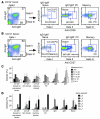Mature B cells class switched to IgD are autoreactive in healthy individuals
- PMID: 17510706
- PMCID: PMC1866247
- DOI: 10.1172/JCI27628
Mature B cells class switched to IgD are autoreactive in healthy individuals
Abstract
Determination of the origin and fate of autoreactive B cells is critical to understanding and treating autoimmune diseases. We report that, despite being derived from healthy people, antibodies from B cells that have class switched to IgD via genetic recombination (and thus become class switched to C delta [C delta-CS] cells) are highly reactive to self antigens. Over half of the antibodies from C delta-CS B cells bind autoantigens on human epithelioma cell line 2 (HEp-2) cells or antinuclear antigens, and a quarter bind double-stranded DNA; both groups of antibodies are frequently polyreactive. Intriguingly, some C delta-CS B cells have accumulated basic residues in the antibody variable regions that mediate anti-DNA reactivity via somatic hypermutation and selection, while other C delta-CS B cells are naturally autoreactive. Though the total percentage was appreciably less than for C delta-CS cells, a surprising 31% of IgG memory cell antibodies were somewhat autoreactive, and as expected, about 24% of naive cell antibodies were autoreactive. We interpret these findings to indicate either that autoreactive B cells can be induced to class switch to IgD or that autoreactive B cells that use IgD as the B cell receptor are not effectively deleted. Determination of the mechanism by which the majority of C delta-CS B cells are autoreactive may be important in understanding peripheral tolerance mechanisms and may provide insight into the enigmatic function of the IgD antibody.
Figures





References
-
- Nemazee D.A., Burki K. Clonal deletion of B lymphocytes in a transgenic mouse bearing anti-MHC class I antibody genes. Nature. 1989;337:562–566. - PubMed
-
- Hartley S.B., et al. Elimination from peripheral lymphoid tissues of self-reactive B lymphocytes recognizing membrane-bound antigens. Nature. 1991;353:765–769. - PubMed
-
- Nossal G.J. Cellular mechanisms of immunologic tolerance. Annu. Rev. Immunol. 1983;1:33–62. - PubMed
Publication types
MeSH terms
Substances
Grants and funding
LinkOut - more resources
Full Text Sources
Other Literature Sources

